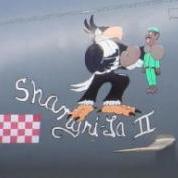-
Posts
2,046 -
Joined
-
Last visited
-
Days Won
90
Everything posted by Hacker
-
I just broke out a pair of new-old-stock Addisons that I've been hoarding for like 15 years so I can get out of the "warbird-pilot-athletic-shoes-and-flight-suit" club.
-
Got it, I didn't get the full picture of what you were saying with respect to the retired dudes being management pilots at the airlines.
-
For what reason? Maybe I had a different experience, but since retiring my attitude is: What's there to hate on bros about? Hell, I don't even really hate on Navy pilots anymore either, despite their known shortcomings as both men and aviators.
-
Card counting is quite a skill. Is that supposed to be a strike against him?
-
No, actually, it isn't supposed to be part of the Executive Branch's powers....it is Congress relinquishing powers it is supposed to have. "Rule making" is supposed to be performed by the "Legislative Branch"....hence, y'know, the name.
-
Government only has the powers that they're given by the people, and everything else they don't have the authority to do. So where's that part in the Constitution about the Government having the power to tell you what to wear?
-
If you can't actually argue the points with logic, it is perfectly valid to just go ad-hominem instead.
-
I can almost read the nametag....General Liquid.
-
This is the most terrible justification in the entire philosophical pantheon.
-
I had a short relationship with a Cherokee 235, as well as getting my private in a Cherokee 160. I chose it over a Bonanza or a Comanche, mostly for market price and what I needed in a "family cruiser" at the time. It was a very enjoyable airplane with a relatively good amount of useful load (1500-ish pounds, depending on gas, etc) and easy to find someone to maintain. It is not particularly expensive to maintain, although mine had its original 70s-era panel and no upgrades, and was going to cost a fortune to update with certified avionics if I wanted to keep playing IFR games with it. The 540 is a reliable engine in my experience too. Don't have much to say about them overall; less expensive than a 182 with comparable performance, can actually haul 4 people (although the back seats are better with kids) and some bags, and typical GA maintenance costs. I sold it rather quickly for PCS reasons, and if my family and mission circumstances were the same, I might own one again....but they aren't. EDIT: Since this is a thread about costs, I'm adding that my costs of ownership probably aren't relevant today as it was 20-ish years ago. I could afford it as a dual-incone-no-kids 1Lt/Capt at the time, though.
-
I'm still perplexed as to why people suddenly believe that formation landings are this massive risk. Compared to the number of times they are performed (with regularity) incident-free (also with regularity, even with student pilots at the helm), the rate of incident/accident is phenomenally low. By definition, based on that data, they're not "risky". Yes, there is a small margin of error (just like a vast many things in high performance military aviation), and the consequences of some modes of error can be severe and/or fatal (just like that same vast number of things in high performance military aviation)...so what makes formation landing now some kind of exception?
-
To be fair, the PIT enterprise at RND produces a flying instructor that is orders of magnitude better than what the FAA's CFI-creation process is. I went to PIT as a salty O-4 who already had more than one IPUG program under my belt, and as @BashiChuni mentioned the "Instructor Fundamentals" academic course taught by the blue-suiters was the first time in my career that the AF had actually made an attempt to teach me how to instruct. It was probably one of the most useful academic courses in my entire AF career. It wasn't perfect, by any stretch, but it actually codified processes to both platform instruct in the briefing room, as well as gave specific tools on finding root causes and instructional fixes to in-flight performance. It actually explained and put names on a bunch of tools that numerous Patch-wearers and IPs had been trying to explain (but were not actually teaching me) in the process of mashing my balls to mush in hour 13 of the DCA IPUG debrief. That course at PIT could have actually used a healthy dash of improvement with some of the WIC processes that were vogue out in the ops world at the time (the "perception-decision-execution" method of root cause analysis, for example), but it was good. It is something that *all* new instructors at every level of the training pipeline could really use.
-

Vance twitter posting 2 killed in T-38 mishap
Hacker replied to Homestar's topic in General Discussion
There's no decision that's too conservative for the risk-averse faction of AF management. -
Those are "solo numbers".
-
Zero, you're still one of my favorite military/aviation cartoonists. You always reminded me of the great Bob Stevens (whose most famous collection of aviation cartoons is "If You Read Me, Rock The Tower"), whom I read a lot of growing up in a mil aviation family. Hope life is treating you well.
-
-
Both are going to be considered in the context of the rest of your resume....and they will further be evaluated based on how you describe what happened to get you into that situation, and how/why you're a better pilot because of it. So, the answer is probably no...they're going to be seen differently...but that's because all black marks are going to be assessed individually in the greater context of what you've accomplished. A "friend" of mine who had been to an FEB was asked in an airline interview if he thought having such a black mark on his record made him less desirable of a candidate for a job offer. He answered that, given the reputation of the quality of candidates for employment at that airline, and that they had their choice of the best of applicants, they probably didn't even need to consider hiring people who had such black marks on their records. The interviewers began to laugh, and said, "if you only knew what kind of skeletons in the closet guys that fly out on the line for us have", and then proceeded on to the next part of the interview. The way we look at, and differentiate between, things like the question you're asking from inside the Air Force fishbowl is not the same way it is going to be looked at from outside the fishbowl. Airlines know that for someone to have the aviation experience required to get called for an airline interview, there is a high probability that they've made some mistakes or been involved in something that's not exactly perfect, and they're okay with that. Again, it all depends on what happened, why it happened, and how you have responded/recovered from it. EDIT: Forgot to mention that my friend in the story was offered a CJO after that interview.
-
I can tell you with high confidence that simply having washed out of IFF is not going to prohibit you from getting hired at the airlines. There are guys flying at the majors with substantially larger black marks on their application than a formal course failure. The airlines are going to take the totality of your experience -- good and bad -- into consideration when deciding to call you in to interview. That being said, you will be asked about what happened, and you will be expected to own the circumstances and performance that resulted in you being there. Most importantly, they're going to want you to show how you used that negative experience to become a better aviator.
-

washout going back to UPT?
Hacker replied to vette32's topic in Air National Guard / Air Force Reserves
Guard/ANG or active duty? -

washout going back to UPT?
Hacker replied to vette32's topic in Air National Guard / Air Force Reserves
When did that happen? -
As a former Compass pilot, I approve this message.
-
I am going out of my way to not "whistle past the graveyard" -- we have no idea what will be ultimately impacted by this situation, and I don't at all believe that cargo is immune to the wrecking ball. The 2008 recession hit Purple heavily, and if it weren't for a contract provision that allowed across-the-board reductions in flying hours instead of furloughs, there certainly would have been cargo guys put out on the street, too. My thought is that if this current thing lasts longer than just the spring/early summer, and really does become another great recession, the job losses (or the delays in re-starting jobs) will mean people will be ordering less stuff online, and there will be a lot less cargo that needs to be moved. Just like in '08. So, I think there will be more than enough misery to go around all sectors of the entire industry, unfortunately. I'm strapping in and preparing for the worst.
-
I don't know that any of them are yet even certain if they're going to furlough or not. That being said, Purple is currently planning on filling classes from the hiring pool throughout the rest of the year.
-
I have owned, rented, been in clubs, owned in a partnership, and looked into several places in between. Aircraft involved have been a 1948 Navion, a 1964 Cherokee 235, a 72 KCAB Citabria, a 1949 T-6G, a 1943 PT-19, and a 1943 SNJ-4 for the relevant club/owning/partnership/sponsorship routes. Each of these routes had their pluses and minuses, and there are good reasons to be found for each path depending on how much money you have to burn, how often you plan on flying, and what you plan on using it for. What I have settled into currently is a partnership/club membership (a fractional owner who leases the airplane to a club) in the PT-19 and a sponsorship in a CAF T-6. Both avenues work well for my balance of cost-vs-use frequency and type. Plus, as others have mentioned, the club (and the CAF) are fun groups of people to fly and socialize with, and also facilitate other flying events like ride-giving, fly-ins, airshows, formation flying, etc. For quite a few years I was heavily leaning toward an RV-8, even having done pre-purchase inspections on a couple potential candidate aircraft and getting some type training and fam from one of the Van's enthusiast groups. I don't have anything bad to say about the aircraft or the community -- I think it is an exceptional combination of value and performance, and would probably have been a good fit for me had I not stumbled into the PT-19 and T-6 opportunities I ended up going with.
-
I heard from a bro who works at one of the adversary air contractors that his company spent last summer roaming through several Central and South American AF bases surveying the condition of numerous A-37s that were for sale. Reportedly, most of them weren't airworthy or in nearly good enough condition to be made airworthy cost effectively.





